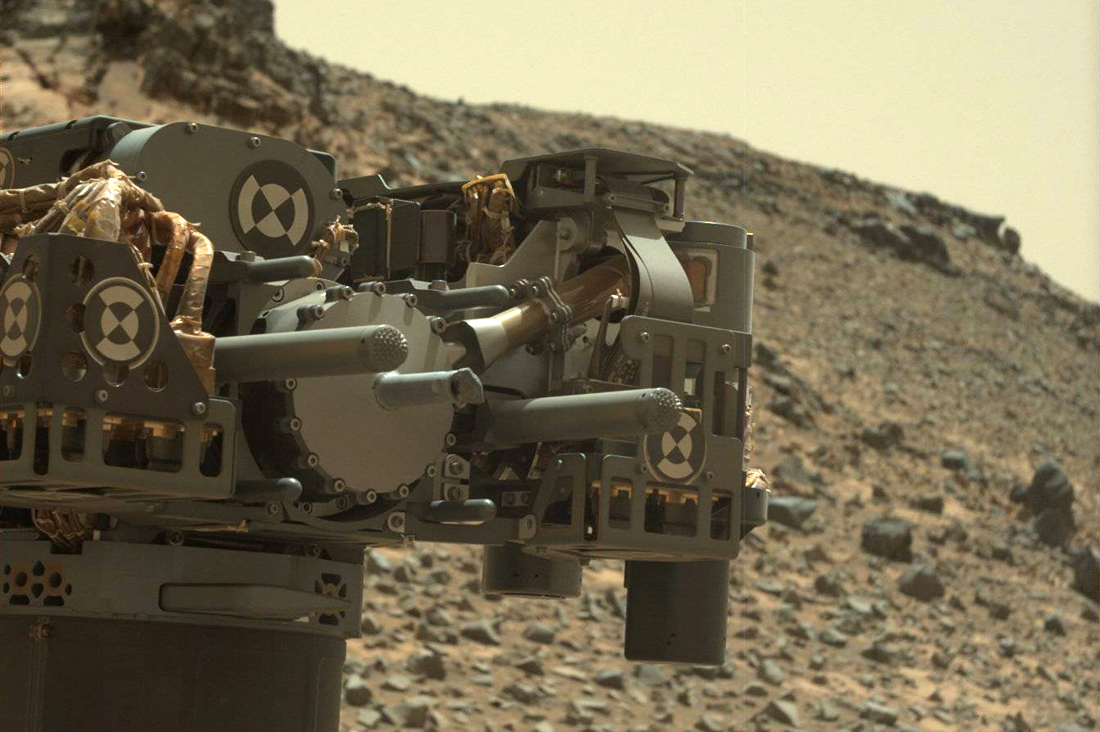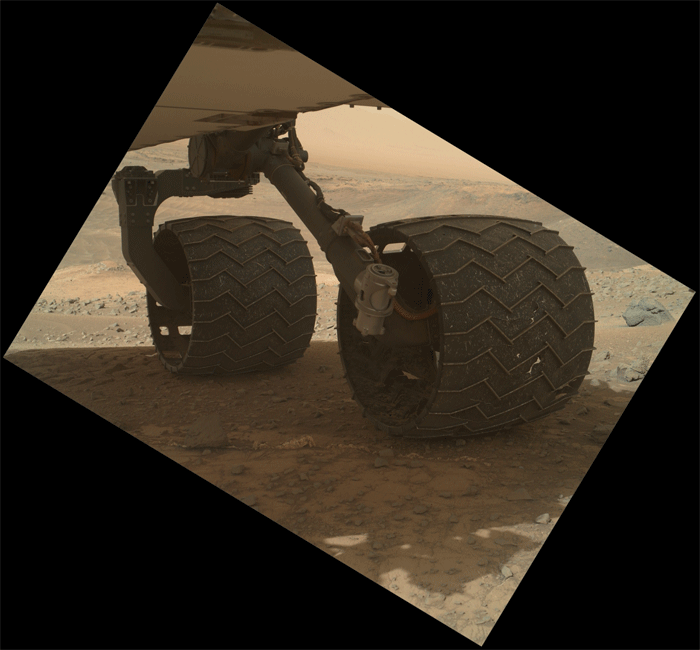Curiosity on Mars: gypsum and nitrates

After a six-month survey of the Puhrump Hills area at the foot of Sharpe Mountain, the rover moved to the mountain, but only 30 meters walked. A small change of location led to new discoveries that require a new stage of research.
Puhrump Hills is a hollow formed, apparently, under the influence of wind erosion. In satellite images, it looks like a very bright spot of bright rocks cleared of sand and dust. As it turned out, there is a whole geological diversity of sedimentary layers, differing in their composition. We had to lay two wells in order to better understand the structure and origin of the rocks.
Even in Puhrump Hills, when viewing the surroundings, thick plaster veins that penetrate the local cliffs fell on the Curiosity panorama. But when the rover went into the Artist`s Drive hollow, it turned out to be a whole plaster kingdom. More precisely, we do not yet know whether this is gypsum, but earlier such white rock turned out to be hydrated calcium sulphate.
')
Particularly surprising is the structure of Garden City.

This form of deposition is called boxwork in Western terminology, and in Russian geology “ shrinkage cracks filled with rock”, in our case gypsum.
If you do not know the scale, you might think that we are considering the ruins of some ancient Middle Eastern or South American settlement. But in this case, the dimensions of Garden City do not exceed two meters in length.

Big size on GigaPan.
Shrinkage cracks, as is clear from the term, arise when water evaporates from clay-like rock. Straight lines and angles are formed if the water was saturated with salts with crystals of the cubic system. These include, for example, common salt (but this does not mean that it was found by the rover).
The MAHLI macro photography from the manipulator opened up a new look at the structure, showing the already disordered chaos of whites living in a black and gray rock.

Large size (10 MB)
Now scientists are more interested in the composition of this dark rock, they are no longer so actively interested in gypsum.
In addition, Curiosity continues to study the internal devices of the sample obtained in Puhrump Hills. At the beginning of March, immediately after the well was drilled, a short circuit slipped through the manipulator and the automation disconnected it. The rover stood for three days without moving with a raised hand.

We have already begun to figure out whether he will be able to continue moving and working if the hand remains forever in this position. It turned out to be quite real, but the scientific potential of Curiosity will plummet. But NASA, too, did not sit idle. Engineers were able to determine where the closure occurred - it turned out in the vibrator of the manipulator. Vibration is used by the rover in two cases: during drilling operations, as in a domestic rotary hammer drill, and when processing typed samples. Curiosity laboratory instruments require no more than 0.15 mm of soil particles, so it has to be sieved, and vibration is also required here. But, in theory, you can do without it, so the performance of the rover is not in danger. Moreover, having understood the causes of the problem, the drivers of Curiosity decided to act in the simplest way - to pretend that nothing happened and to work under the previous program. If the closure is repeated, then they will think further.
This tactic worked. They successfully sifted the soil, sent samples for research and dumped the waste.

Meanwhile, previous research results gave a curious and encouraging result - nitrates were found in the Martian soil, i.e. compounds in which there is one nitrogen atom. In everyday life, “nitrates” can most often be heard in the sense of “chemical fertilizer” or “food additive”. There is no virgin or sausage on Mars, so the origin of nitrates should have a different reason.
Nitrogen oxides were first identified on Mars almost two years ago when they studied the well itself, where chlorobenzene was discovered. But later we found out that nitrates are part of almost all the studied soil types, only the content ranges from 0.1% to 1%. This is pleasing in the sense that future settlers will not have to import fertilizer with them, but the problem is that agricultural crops require nitrate content in the range of 0.01%

Nitrogen is the fourth most abundant element from which living organisms form on Earth. Without it, the formation of protein, RNA and DNA. Molecular gaseous nitrogen N2, of which for the most part (78%) the atmosphere of the Earth consists, does not react with anything. Nitrogen was found in the same form in the atmosphere of Mars, although in a much smaller amount (2%). Despite the fact that all earthly living beings have a need for this element, mechanisms for the assimilation of nitrogen from the atmosphere have developed only a few groups of primitive microorganisms, including chemolithotrophic cyanobacteria. The difficulty of involving nitrogen in redox reactions lies in a strong triple bond between the atoms, the gap which needs to spend a lot of energy. Nitrogen oxidation occurs at high temperatures and pressures, such as lightning discharges or meteorite impacts.
An additional intriguing factor is the fact that various groups of microorganisms, including chemolithotrophs and cyanobacteria, have already been mentioned in other studies, in the context of possible indirect signs of past Martian life. However, the results of meteorite falls on Mars are presented much more clearly than the hypothetical signs of vital activity of primitive unicellular Martians, therefore the final answer is again postponed.
Curiosity is now planning to leave Garden City and move on, towards uncertainty and new discoveries.

Source: https://habr.com/ru/post/366665/
All Articles